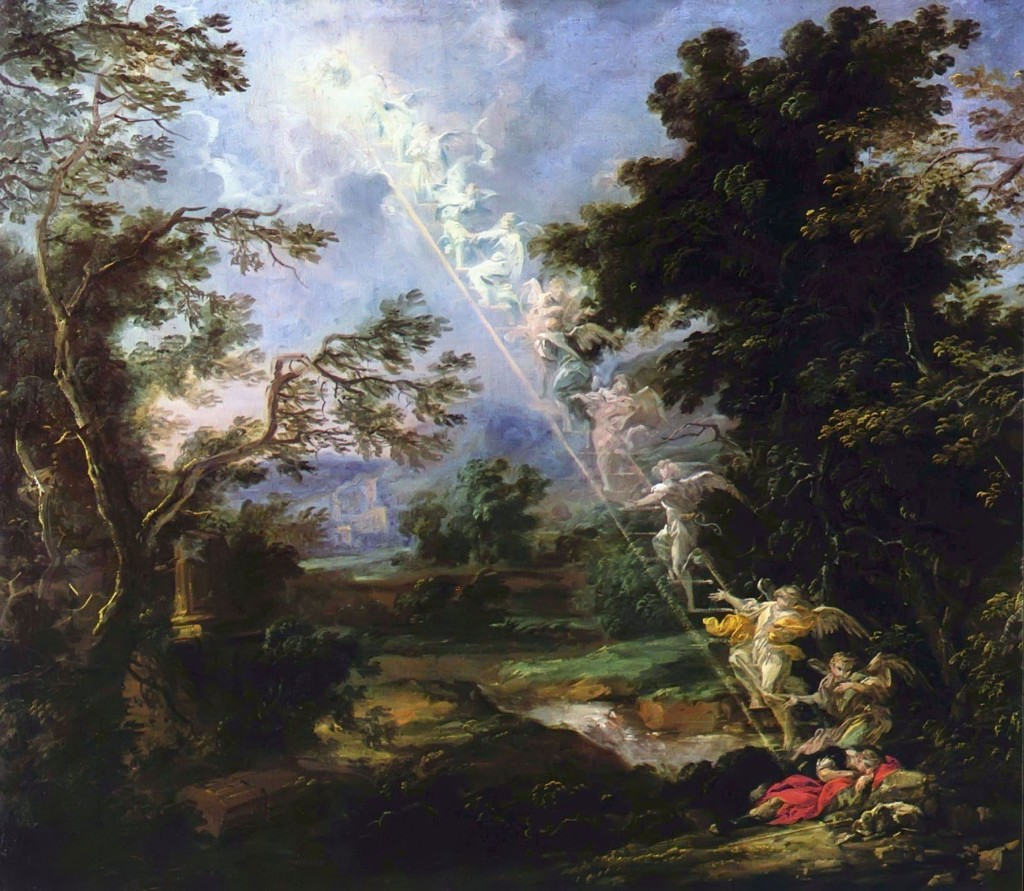In the stream of this most instructive typology on the subject (see prior post on Jacob and Esau), we are now carried along to its climaxing feature—
Jacob’s Dream
On the first night of his flight from the murderous wrath of Esau, Jacob, using a stone for a pillow, lay down to rest:
“And he dreamed, and behold a ladder set up on the earth, and the top of it reached to heaven: and behold the angels of God ascending and descending on it.” Gen. 28:12.
What does the dream mean?—Being another facet of the same typology, it must necessarily be a prefigurement of a note-worthy event to overtake God’s people, the Jacobites.
Since the ladder, with one end on the earth and the other in heaven, symbolizes Christ (Patriarchs And Prophets, p. 184), and since the angels walking up and down the ladder are His messengers (The Great Controversy, p. 512), the whole signifies that Christ shall establish through Himself a sure and constant communication between heaven and earth.
“And it shall come to pass in that day, I will hear saith the Lord, I will hear the heavens, and they shall hear the earth.” Hos. 2:21.
The next step in the typology takes into consideration—
The Mothers of Jacob’s Descendants.
Along the chronological path of this numerous-phased typology, we now in thought follow Jacob on to Padan-Aram. There he took unto himself four wives—Leah and Rachel, the daughters of Laban; then Zilpah and Bilhah, their respective maids. These four were the mothers of the twelve sons of Jacob, who in turn were the fathers of the twelve tribes of Israel.
In this type-progression of spiritual Israel, only one of the four, Leah, was Jacob’s legal wife. Only she, therefore, can typify the true and legal church—the one which was organized in Jerusalem by the twelve-tribe kingdom, and which finally evolved into the Christian Church.
Rachel must necessarily represent a sister church—the one organized in Samaria by the ten-tribe kingdom and dispersed with it among the Gentiles.
Zilpah and Bilhah, being “strangers” and servants to Leah and Rachel, must necessarily represent subsequent churches of Gentile origin.
From these four lines descended the anti-typical children of Israel. And what is true in the physical genealogy must he true also in the spiritual genealogy. Hence, while the antitypical, like the typical, twelve tribes come through both Israelite and Gentile mothers, yet they are begotten by one and the same father—an Israelite.
Dispersed by God throughout the Gentile nations, both Judah (the two-tribe kingdom) and Israel (the ten-tribe kingdom) were swallowed up by them. Then, too, the Christian Church, herself but an up-shoot from the Jewish Church (Christ’s disciples and apostles, as well as the church’s early converts, were purely Jews, remember), dropped her Old Testament title “Jewish” as she took her New Testament title “Christian.” Then she gradually lost her Jewish foliage amid the foliage of the ingrafted Gentile branches.
Now as we leave this phase of the typology, we enter that of—
Jacob’s Journey Homeward.
After twenty years of faithful service in Padan-Aram, in the sharp, overreaching employ of Laban, his uncle, Jacob at last turned his face and his steps homeward toward his father’s house in the land of promise.
But trouble overtook him. While grappling with his fears as to the outcome of his imminent meeting with Esau “there wrestled a man with him until the breaking of the day.” Gen. 32:24.
Here lay down the man Jacob and rose up the man Israel, exemplifying the agonizing experience through which his posterity must victoriously pass before they, too, receive a new name, pass from sons of Jacob to sons of God, become Israelites indeed. Having gained the victory over this test, “the time of Jacob’s trouble,” they will reach home, the land of promise—the happy end of their long and troubled journey.
On this trying and testing time the Spirit of Prophecy comments: “A decree went forth to slay the saints, which caused them to cry day and night for deliverance. This was the time of Jacob’s trouble”—Early Writings, pp. 36, 37. (See also Patriarchs and Prophets, pp. 202, 203.)” — Shepherd’s Rod Vol. 1, Tract Ed., pp. 33-37
Now, as Jacob’s retirement from his servitude in Padan-Aram ends with his returning home, the typology continues with—ISRAEL’S GOING INTO EGYPT. (to be continued on the next post).


{ 0 comments… add one now }